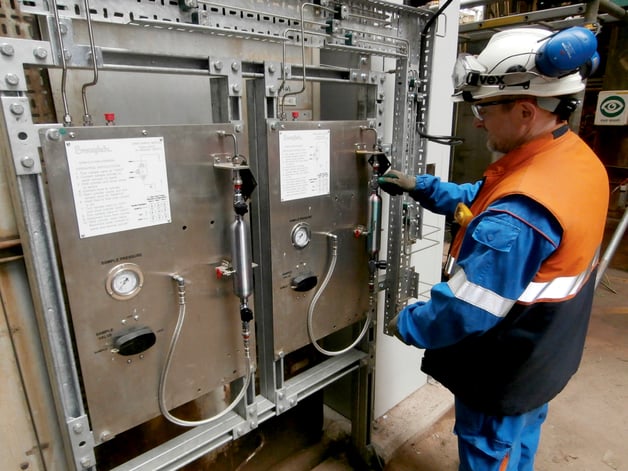Share this
How to Achieve Closed Loop Sampling Quality Control & Management
by Morgan Zealear on 3/17/20 8:45 AM

Achieving closed-loop sampling quality control across the variety of sampling needs in a Northern California refinery is a multi-dimensional challenge. It doesn’t just involve a detailed understanding of the specific needs of each sampling process and designing of sampling stations to consistently and safely obtain representative samples. You also need an enterprise-wide approach to documenting sampling station configurations, procedures, and maintenance requirements.
Considering the range of closed-loop sampling needs, especially in Contra Costa County where more layers of governing authorities enforce environmental and safety regulations, you should seek the guidance of a vendor who has proven experience in designing sampling systems. With expert design and assembly services, it’s possible to achieve closed-loop sampling quality control and manage associated operator safety issues.
Design Closed Loop Sampling Systems For Process Quality Control
Sampling system design is determined by the type of fluid, its pressure and temperature, environmental and safety regulations, as well as the need for representative and compatible sampling. Samples can be captured as part of a continuous, or fast loop, process or by a temporary disruption of the transport flow. Cylinders, sample bottles, or fixed volumes hold the samples. Once obtained, representative samples need to be maintained at the same process conditions until they are analyzed at the onsite or remote laboratory.
A grab sampling system tailored to the specific process application is the foundation for closed-loop sampling quality control. Capabilities and features that help ensure the sample quality and consistency may include:
- Valve technology and flow geometry to minimize “dead volume”—fluids trapped in non-flowing locations of sample loops that jeopardize the sample quality by contaminating future sample concentrations
- Coolers or heat exchangers to reduce sample temperatures to a safe handling range for capture and transportation to the laboratory
- Tube fittings that eliminate the possibility of leak points associated with National Pipe Thread (NPT) connections
- Integrated purge lines to clear pre- and post-sample residue, like viscous fluids associated with sour crude trapped in the process needle (straw effect), using the appropriate gas or liquid solvent during low-pressure liquid samples
- Appropriate sample cylinders that are vertically-oriented with bottom-up fill for liquids or top-down fill for gases
- Sample cylinders that permit purging of transport lines without purging the cylinder itself
- Permanent instructions posted on the station to encourage reliable, consistent, and safe sampling procedures
An experienced vendor will also factor in relevant variables such as sources of contamination, adsorption, permeation, phase change, or chemical reactions that have the potential to affect sample quality. They’ll propose methods, materials, and instrumentation such as gauges, meters, and flow indicators to mitigate these problems. Overall, the proposed design should minimize the number of sequencing steps required to obtain a sample to help ensure consistent sampling quality—and operator safety.
Safety and Ergonomics Contribute to Closed Loop Sampling Quality
Closed-loop sampling quality control goes hand-in-hand with safe operations. Eliminating the factors that jeopardize operator safety decreases the likelihood of sampling procedure mistakes that undermine sample quality. Sampling process safety is enhanced by:
→ Ensuring the sample transport line is returned to a lower pressure location in the process
→ Designing vent capture to protect personnel and meet the Bay Area Air Quality Management District (BAAQMD) and Division of Occupational Safety and Health, or Cal/ OSHA, standards
→ Employing quick-connect cylinder and hose fittings for easy and secure attachment and detachment to the station
→ Using cylinders designed to meet Department of Transportation (DOT) or Transportable Pressure Equipment Directive (TPED) regulations
→ Adding cylinder handles for easier management of samples
→ Including outage tubes to provide vapor space in cylinders, allowing liquid gas to safely expand in the event the ambient temperature rises
→ Incorporating rupture discs, relief valves, and expansion chambers to eliminate the possibility of cylinder explosions
In addition to the design and safety features of the sampling station itself, location also plays a factor in facilitating a consistent and unencumbered sampling procedure. Sample stations should be located so that they are easily accessible, well-lit, and have ample surrounding workspace for operators to carry out the sampling procedure.
In instances involving sampling of certain hazardous fluids, such hazardous fluids containing H2S, requirements may be even more stringent. The closed-loop grab sampling station may need to be completely enclosed, with a secure door for access, observation window, and eductor to capture the vent. Local regulations may also require eye-wash and/ or safety showers to be in close proximity.
Although specific sampling procedures are usually attached to the closed-loop sampling station to remind operators of the proper procedures, a digital copy of all sampling procedures, station designs, and recommended maintenance procedures should be centrally maintained and updated as needed. Centralized management of this information, ideally in an asset management system, helps promote a standardized approach to closed-loop sampling quality control, track the operational status of each station, and maintain the reliability of the individual sampling stations.
Manage Closed-loop Sampling Quality Control More Easily
Achieving closed-loop sampling quality control requires sampling stations designed for the specific sampling environment. System design and components should facilitate sampling procedures that minimize any risks or mistakes that jeopardize sample quality or threaten operator safety. A well-designed closed-loop sampling system enables a consistently-repeatable process that safely captures a representative sample and preserves it until analyzed.
Swagelok Northern California has been meeting the fluid system component needs of refineries in the Bay Area for more than 50 years. We now offer standard and customized closed-loop sampling solutions for use in all types of plants and facilities. Our local, factory-certified experts will assess your requirements, taking into account time delay, phase change, and common sample system errors then design and assemble a system to ensure sample quality and operator safety. Swagelok also offers hands-on training regarding the proper use and maintenance of sampling systems.
To find out how Swagelok Northern California can help address your closed-loop sampling quality needs, contact our team today by calling 510-933-6200!
 About Morgan Zealear | Product Engineer, Assembly Services
About Morgan Zealear | Product Engineer, Assembly Services
Morgan holds a Bachelor of Science in mechanical engineering from University of California at Santa Barbara. He is certified in Section IX, Grab Sample Panel Configuration and Mechanical Efficiency Program Specification (API 682), and he is well versed in B31.3 Process Piping Code. Before joining Swagelok Northern, he was a manufacturing engineer at Sierra Instruments, primarily focused on capillary thermal meters for the semiconductor industry (ASML).
Share this
- Archive (465)
- Assembly Services (207)
- About (100)
- Seal Support Systems (96)
- Best Practices (88)
- Training Services (74)
- Fittings (51)
- Semiconductor Applications (49)
- Hoses and Flexible Tubing (47)
- Regulators (44)
- Tubing (42)
- Grab Sampling Systems (32)
- Sampling Systems (32)
- Gas Systems (30)
- Services (30)
- Downloads (29)
- Valves (24)
- Application Support (18)
- Orbital Welding (17)
- Case Studies (13)
- Steam Systems (13)
- Frequently Asked Questions (12)
- Tools (12)
- Measurement Devices (7)
- Subsystems (6)
- Thermal Management (6)
- September 2023 (1)
- August 2023 (2)
- June 2023 (1)
- March 2023 (3)
- February 2023 (3)
- January 2023 (4)
- December 2022 (4)
- November 2022 (4)
- October 2022 (4)
- September 2022 (1)
- August 2022 (3)
- July 2022 (2)
- June 2022 (4)
- May 2022 (1)
- April 2022 (2)
- March 2022 (1)
- February 2022 (2)
- January 2022 (3)
- December 2021 (1)
- November 2021 (6)
- October 2021 (6)
- September 2021 (8)
- August 2021 (4)
- July 2021 (3)
- June 2021 (6)
- May 2021 (6)
- April 2021 (7)
- March 2021 (5)
- February 2021 (4)
- January 2021 (6)
- December 2020 (5)
- November 2020 (6)
- October 2020 (6)
- September 2020 (8)
- August 2020 (7)
- July 2020 (8)
- June 2020 (8)
- May 2020 (6)
- April 2020 (9)
- March 2020 (7)
- February 2020 (10)
- January 2020 (21)
- December 2019 (23)
- November 2019 (21)
- October 2019 (22)
- September 2019 (21)
- August 2019 (22)
- July 2019 (23)
- June 2019 (20)
- May 2019 (23)
- April 2019 (22)
- March 2019 (21)
- February 2019 (20)
- January 2019 (21)
- December 2018 (14)
- November 2018 (19)
- October 2018 (23)
- September 2018 (17)
- August 2018 (29)
- July 2018 (11)
- June 2018 (6)
- May 2018 (5)
- April 2018 (4)
- March 2018 (5)
- February 2018 (3)
- January 2018 (3)
- December 2017 (2)
- November 2017 (4)
- October 2017 (3)
- September 2017 (2)
- August 2017 (6)
- July 2017 (4)
- June 2017 (4)
- May 2017 (4)
- April 2017 (3)
- March 2017 (4)
- February 2017 (3)
- January 2017 (3)
- December 2016 (3)
- November 2016 (3)
- October 2016 (3)
- September 2016 (5)
- August 2016 (5)
- July 2016 (4)
- June 2016 (5)
- May 2016 (3)
- April 2016 (4)
- March 2016 (5)
- February 2016 (11)
- January 2016 (1)
- December 2015 (3)
- November 2015 (4)
- October 2015 (3)
- September 2015 (4)
- August 2015 (4)
- July 2015 (8)
- June 2015 (5)
- May 2015 (3)
- April 2015 (4)
- March 2015 (4)
- February 2015 (3)
- January 2015 (4)
- December 2014 (2)
- November 2014 (3)
- October 2014 (4)
- September 2014 (4)
- August 2014 (4)
- July 2014 (5)
- June 2014 (4)
- May 2014 (4)
- April 2014 (5)
- March 2014 (4)
- February 2014 (3)
- January 2014 (4)
- December 2013 (5)
- November 2013 (3)
- October 2013 (4)
- September 2013 (3)
- August 2013 (5)
- July 2013 (5)
- June 2013 (5)
- May 2013 (3)
- April 2013 (6)
- March 2013 (4)
- February 2013 (4)
- January 2013 (8)
- December 2012 (4)
- November 2012 (6)
- October 2012 (6)
- September 2012 (4)
- August 2012 (4)
- July 2012 (4)
- June 2012 (4)

.webp?width=210&height=70&name=StickyLogo%20(5).webp)